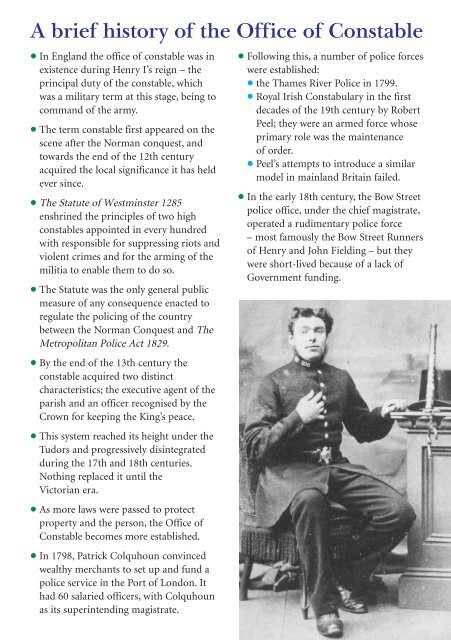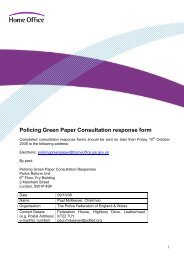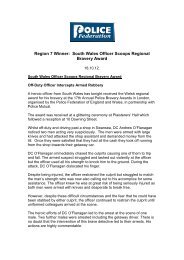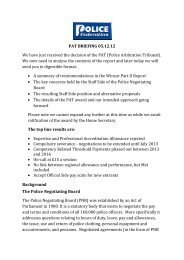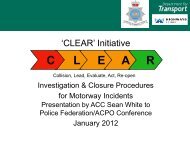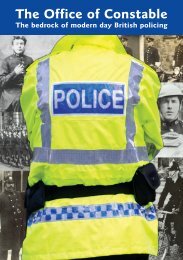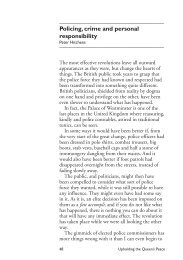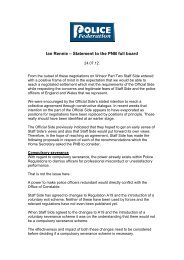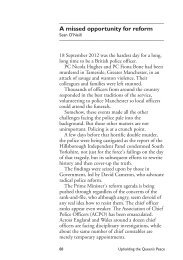Office of Constable pamphlet - Police Federation
Office of Constable pamphlet - Police Federation
Office of Constable pamphlet - Police Federation
Create successful ePaper yourself
Turn your PDF publications into a flip-book with our unique Google optimized e-Paper software.
A brief history <strong>of</strong> the <strong>Office</strong> <strong>of</strong> <strong>Constable</strong><br />
• In England the <strong>of</strong>fice <strong>of</strong> constable was in<br />
existence during Henry I’s reign – the<br />
principal duty <strong>of</strong> the constable, which<br />
was a military term at this stage, being to<br />
command <strong>of</strong> the army.<br />
• The term constable first appeared on the<br />
scene after the Norman conquest, and<br />
towards the end <strong>of</strong> the 12th century<br />
acquired the local significance it has held<br />
ever since.<br />
• The Statute <strong>of</strong> Westminster 1285<br />
enshrined the principles <strong>of</strong> two high<br />
constables appointed in every hundred<br />
with responsible for suppressing riots and<br />
violent crimes and for the arming <strong>of</strong> the<br />
militia to enable them to do so.<br />
• The Statute was the only general public<br />
measure <strong>of</strong> any consequence enacted to<br />
regulate the policing <strong>of</strong> the country<br />
between the Norman Conquest and The<br />
Metropolitan <strong>Police</strong> Act 1829.<br />
• By the end <strong>of</strong> the 13th century the<br />
constable acquired two distinct<br />
characteristics; the executive agent <strong>of</strong> the<br />
parish and an <strong>of</strong>ficer recognised by the<br />
Crown for keeping the King’s peace.<br />
• This system reached its height under the<br />
Tudors and progressively disintegrated<br />
during the 17th and 18th centuries.<br />
Nothing replaced it until the<br />
Victorian era.<br />
• As more laws were passed to protect<br />
property and the person, the <strong>Office</strong> <strong>of</strong><br />
<strong>Constable</strong> becomes more established.<br />
• In 1798, Patrick Colquhoun convinced<br />
wealthy merchants to set up and fund a<br />
police service in the Port <strong>of</strong> London. It<br />
had 60 salaried <strong>of</strong>ficers, with Colquhoun<br />
as its superintending magistrate.<br />
• Following this, a number <strong>of</strong> police forces<br />
were established:<br />
• the Thames River <strong>Police</strong> in 1799.<br />
• Royal Irish Constabulary in the first<br />
decades <strong>of</strong> the 19th century by Robert<br />
Peel; they were an armed force whose<br />
primary role was the maintenance<br />
<strong>of</strong> order.<br />
• Peel’s attempts to introduce a similar<br />
model in mainland Britain failed.<br />
• In the early 18th century, the Bow Street<br />
police <strong>of</strong>fice, under the chief magistrate,<br />
operated a rudimentary police force<br />
– most famously the Bow Street Runners<br />
<strong>of</strong> Henry and John Fielding – but they<br />
were short-lived because <strong>of</strong> a lack <strong>of</strong><br />
Government funding.


